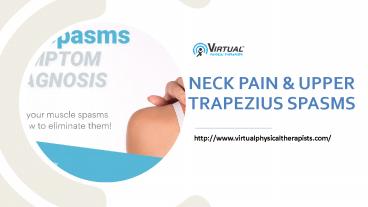Neck Pain & Upper Trapezius Spasms (1) - PowerPoint PPT Presentation
Title:
Neck Pain & Upper Trapezius Spasms (1)
Description:
Neck pain and upper trap spasms are common conditions affecting almost everyone at least once in their life. Check this PPT and know how to solve this problem. – PowerPoint PPT presentation
Number of Views:27
Title: Neck Pain & Upper Trapezius Spasms (1)
1
NECK PAIN UPPER TRAPEZIUS SPASMS
http//www.virtualphysicaltherapists.com/
2
Neck pain and upper trap spasms are common
conditions affecting almost everyone at least
once in their life. It also afflicts others on a
regular basis. Most people experience waking up
with a painful, stiff neck. The pain and spasms
are usually accompanied by a loss of normal neck
range of motion, making daily activities
difficult such as turning your head or the
inability to look behind when driving. The pain
can range from a dull ache to sharp, stabbing
pain. We often blame these knots on stress and
shoulder problems. The internet is full of
treatments and stretching exercises that may give
transient relief, but the twinges and cricks
often return and even worsen What Causes Muscle
Spasms in your Upper Trap and Scapular Regions?
There are many reasons for muscle spasms
including fatigue, dehydration, blood
restriction, nerve injury, electrolyte imbalance.
Muscles also go into spasm as a way for the body
to protect an area from further injury. An
example would be a dislocated shoulder the
muscles around the shoulder go into spasms to
prevent further movement. When the brain senses
instability or tissue damage around the spine, it
sends out a signal that causes muscle guarding. A
protective spasm is the brains reflexogenic
attempt to prevent further insult to injured
tissues. By splinting the area with spasms,
muscle locking effectively reduces painful
joint movements and gives you a warning that
something is wrong.
3
Injury/stress to the neck triggers produces these
muscle spasms in the trapezius and scapular
regions. These knots are usually the size of a
quarter to half-dollar and they are dense and
tender to touch. Our first thought is to stretch
and massage these muscles, but this does NOT
address the cause of the spasms. Massage,
ultrasound, stretching, trigger point injections
can all provide relief of tight muscle or muscle
spasms but the relief is usually only
temporary. A mechanical assessment
will uncover the root cause of pain and
spasm. If movement and/or positions affect your
neck symptoms, then your symptoms are the result
of a mechanical problem. (If your symptoms are
not affected by movement then further testing is
needed to determine if your symptoms are the
result of a non-mechanical disorder.) A trained
clinician can assess your movement patterns to
determine the underlying root cause of your pain
and spasms. When the root cause is determined
then the mechanical disorder can easily be
corrected.
4
Misconceptions 1. Muscle relaxers are the
proper treatment for my neck spasms. FALSE. Musc
le relaxers are not treating the problem, only
masking the symptoms. 2. Trigger points are
the cause of the knots in my neck and need to be
targeted with massage and injections. FALSE. The
muscle spasms are referred from an underlying
cervical disorder. 3. Massage, Active release,
foam rolling are the best treatments for tight
neck muscles. FALSE. The muscles are tight
because of an underlying mechanical disorder of
the spine. Only when this disorder is corrected
will the tightness and spasms go away. 4. I
have an inflamed trapezius muscle. FALSE. The
trapezius muscle is not inflamed. It is in a
protective spasm because of an underlying
mechanical disorder stemming from the cervical or
upper thoracic spine.
5
How Do You Treat Neck and Shoulder Pain? Since
most neck pain is mechanical or caused by stress
or damage to joints and soft tissue, the
treatment must also be mechanical or movement
exercise. An assessment of the quality/quantity
of movement as well as the effect on symptoms
determines which underlying structures are
problematic. Often there is a directional
preference or movement in one direction that
reduces symptoms. Posture correction often
coincides with reducing neck and or shoulder
symptoms. Schedule a Mechanical Assessment now
with one of our specialists so they can determine
the underlying cause of your symptoms and help
you with a self-treatment program https//web.vpt
sapp.com/patientlogin
6
Virtual physical therapists
- info.virtualphysicaltherapists_at_gmail.com
- http//www.virtualphysicaltherapists.com/































